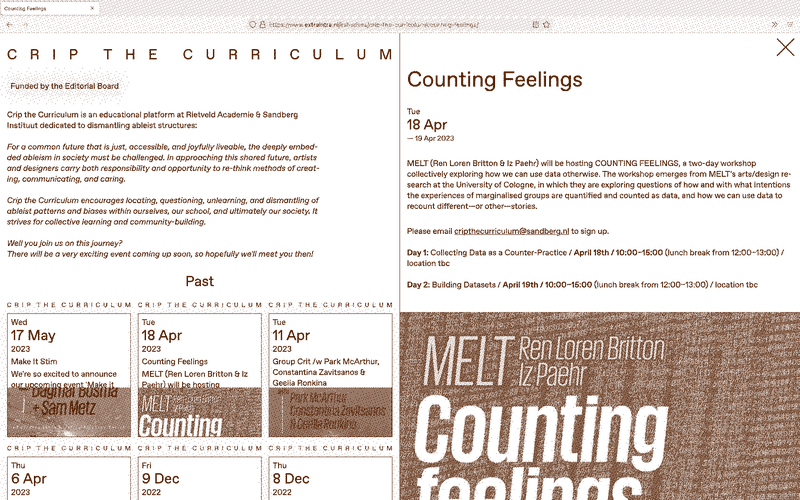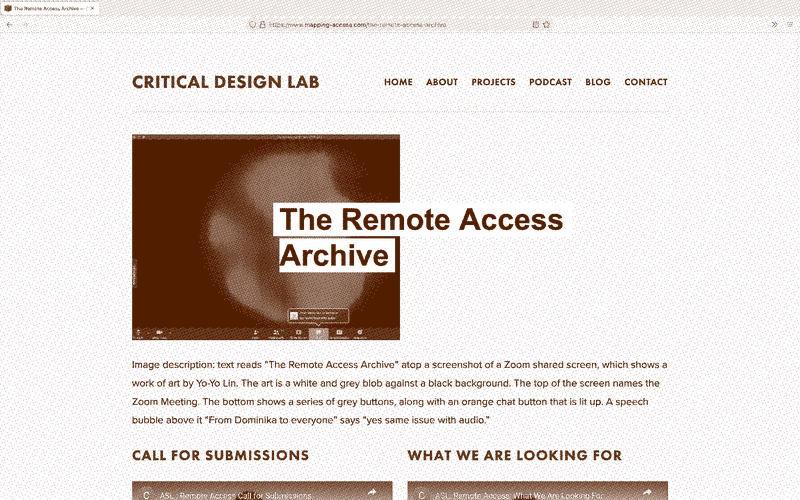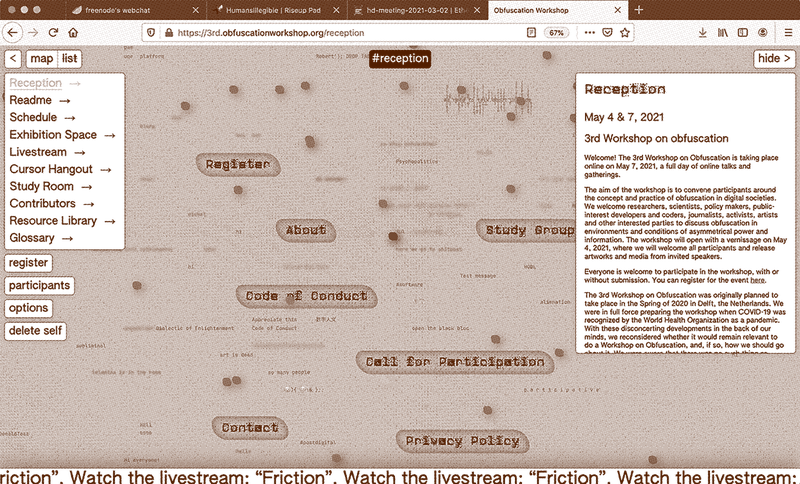chapter
Thresholds of Access
00:49 Welcome to chapter two, ‘Thresholds of Access’. As you can see, there are two new hosts with you, which are me, Chloë, and Senka, who is sitting across from me. We also welcome three new speakers. Ooooh yeah we’re all here First is Karl Moubarak. He’s a designer and a tool-builder and member of Hackers & Designers. See: https://www.hackersanddesigners.nl His practice is rooted in the digital sphere and focuses on research, development, and social activation of experiments or interfaces, infrastructures, and on and offline sites for exchange. Our second speaker is Ren Loren Britton, who works in the art and design studio MELT with Iz Paehr. As MELT, they build worlds along three arts and design research structures: Anti-Ableist Technologies, the Meltionary and Zeitgeber. MELT’s work resources ways of being together that figure in the present and future our flourishing. For more about MELT, see: http://meltionary.com/MELT.html And finally, Ania Molenda, who has been a member of the Hybrid Publications group in Going Hybrid. Senka <3 Ania is an independent researcher, curator, writer, educator, and co-founder of publishing platform Amateur Cities. See: https://amateurcities.com. Her work focuses on the cross-section between spatial practices, technology, ecology, and their socio-cultural impact. Her current project ‘Unfolding the Archive’ at the Nieuwe Instituut, has been supported by the NWO Museum Grant. This project will explore how can the the National Collection for Dutch Architecture and Urban Planning housed and managed by the Nieuwe Instituut use the digital affordances of their born-digital collections to make them accessible in dynamic, networked, multimodal, and multivocal ways.

02:26 In this chapter, we’ll be talking about access on both a human and a technological level with a focus on live cultural events, their structure, and their afterlife. Who is included in live events and who isn’t? How can an audience that was not part of a live cultural event feel included and engaged afterward? Access as a topic influences so many facets of hybridity. From inclusive and customizable design to the mediations that technology can allow for, the interfaces that exist on platforms, but also the considerations and concerns that practitioners come with and bring to the conversation. Equally, access also pertains to knowledge production. Why are there mushrooms and unicorns in the back? How information is built, who it is shared with, how it is communicated? So, indeed, we are looking at access quite broadly. I would like to ask all of the speakers to situate the notion of access within their practice and their research.
Where Does Access Take Place?
03:56 Thank you for the lovely introduction. they were summoned by the magical giulia My work usually takes place in interdisciplinary contexts. In this context, ‘access’ is about bridges between different forms of knowledge - between different academic backgrounds, different domains, or different cultural backgrounds. It’s also very often related to technology, where digital literacy plays a role. In each project, there are different constellations or intersections of access. It can, of course, also relate to different forms of ability or disability, but that axis is not central to my work.
05:05 Thanks for the question and it’s really nice to be here. As was mentioned, I’m here to represent two people. I’m Ren and my collaborator Iz is joining us on the livestream. We work together as MELT, and in our practice, access functions as a creative motor for the way we work through practices and problems. We work with a disability justice and trans-feminist-oriented practice. We’re primarily concerned with making access for disabled people and thinking about the multiplicity of formats that that might require. We also think about multimodal design quite a lot. An example of that is a recent project we have called ‘Counting Feelings’. ‘Counting Feelings’ was a two-day workshop collectively by MELT, exploring how we can use data otherwise. It took place online on 18 and 19 April 2023. See: https://www.extraintra.nl/initiatives/crip-the-curriculum/counting-feelings In that work, we are looking at what would data mean for trans and disabled people, if ableism and anti-queer sentiment were not the organizing factors of our everyday lives. We’re developing other ways of thinking with data practices. We have, for example, a work that’s a objectweighted blanket. And with that weighted blanket, we have it both as something that you can feel, textsomething that you can read like a booklet with all of the information of the data bits inside of it, and also audiosomething you can listen to. We are thinking through multiple layers of access-making through something very much coming out of our community as well. Did someone say mushrooms? and unicorns?

Webpage of the ‘Counting Feelings’ hosted by MELT.
06:26 I’m working with technology and infrastructure and tools, at least in the context of this research consortium and with the work group that I’ve been participating in – through Hackers & Designers and with The Hmm – Participatory Livecasting. We were thinking a lot about access from two axes. One is disability and videomaking livestreams accessible to disabled people in different ways, to cater to different disabilities. The second axis of access is about ecology and computation power, network bandwidth, and this kind of stuff. My main role in the project, from its development until now, has been thinking about the technical ways in which videoa technologically sustainable and light streaming service, for lack of a better word, could work for The Hmm.
07:31 One example was discussed by Lilian Stolk in the first chapter. See ‘1: Sound and Temporarlity’. The Hmm was trying to organize an event around non-visual culture. But for a year or two, they had this websitelivestream platform in which, it turned out, a lot of assumptions were embedded. For now they’re just in the digital background, technology hasn’t progressed enough for now unfortunately For this event, they reached out to me and said: ‘Hey, can we update the livestream so that this one event is presented as audioaudio-first, instead of a videovideo?’ The axes of access, thanks for that Karl, very important videoThe video would be accessible but as a secondary option. Then I was confronted with all of my assumptions of how the audio-visual aspect of a stream was at the forefront and embedded as a default everywhere. From the front-end to the back-end code, to the connection with the streaming service. If nothing is declared about the streaming preference, video is default. This begs the question, why is this visual culture so central? The simple fix was to create an option to pick for each event; what would be the automatic default streaming mode? You can listen back to this event in The Hmm livestreaming and recordings sections, on their livestream platform: https://live.thehmm.nl/n0n-visu4l-1nt3rnet-cultur3
08:58 Thank you so much! Let’s look back. I want to ask you about what has been lost, but also what has been gained during the COVID pandemic. And, based on those lessons, what we can ask for or demand from cultural institutions when we talk about hybrid events? /camera:180
09:25 I reached out to Ren, specifically in context to this question and with your work concerning disability justice and just in general, cultural hybridity. There was a pandemic and with it came state-enforced restrictions on mobility and movement. camera:30 So, access to culture became a problem for able-bodied people. We’re here in this two-year consortium about hybridity, specifically because of access being a problem for able-bodied people. Now, of course, those restrictions on mobility have been lifted. But something important to think about from a disability and crip justice perspective is the immobility of some disabled people – bedridden people, people that cannot leave the spacehouse because of their immunodeficiencies or whatever it is – these immobilities and limitations are also state-enforced. It’s not that it’s in their body, or it’s their choice. This is something that’s imposed on them. They have been demanding a hybrid cultural sector far before the pandemic. ‘The United Nations (UN) Convention on the Rights of People with Disabilities entered into force in 2011. It enshrined, among other rights, the right of people with disabilities to access cultural venues such as theatres, cinemas and museums, and to enjoy cultural materials, books, films and music in an accessible format’ (https://www.ohchr.org/en/instruments-mechanisms/instruments/convention-rights-persons-disabilities). However, this is often an after-thought for institutions. So disabled voices or voices that speak from a disability and crip justice perspective are very important to hear. Now, in post-pandemic, hybridity is a trend. We’re talking about it, and I think an immediate request or demand is to center disabled voices in these developments rather than continue to move forward with our mostly able-bodied realities.
11:18 Maybe I can add that so many disabled activists and folks at the beginning of the pandemic said: ‘We’ve been asking for hybridity forever and now when non-disabled people need it, it happens.’ It shows that these are really important, critical questions for cultural institutions to keep in place, while also keeping hybridity playful. A lot of the work that Iz in I do as MELT is about understanding access as a creative force, as a playful thing, or as something that creates a lot of potential for connection. Seriously questioning visual culture is a red thread between these two conversations already. But it’s a difficult question for the ‘visual arts’ and design and internet culture field. Is what we do still egitimate if we pass on visuals? Rather than seeing it as only a loss of one way of participating, maybe some other ways of joining are made possible through hybridity. This is what I understand you’ve been looking into, which is exciting.
Access as Creative Force
12:07 Do you have some examples of that playfulness? What are ways we can do that?

CRITICAL DESIGN LAB webpage of the ‘Remote Access Archive’ project.
12:14 Next week, Iz and I are hosting a Crip Hackathon with Heinrich-Böll-Stiftung. websiteParticipating accessibly at the Hackathon is entirely online because we are making sure that people that are immunodeficient or anyone who’s disabled can also still join. And we’re sending everyone a objectpackage. And in that package is a toolbox of things that you might need to imagine. So that’s one way that we’re still practicing with that. We also like the work of the Critical Design Lab and Aimi Hamraie, especially their project ‘Remote Access Archive’. ‘The Remote Access Archive will gather stories, documents, and other information about how disabled people have used technology to interact remotely’ - https://www.mapping-access.com/the-remote-access-archive It looks at this exact problem: how is access made or lost? It records the moments in which access is no longer possible, which brings up more radical claims and questions that we can ask.
13:16 In the context of our group, one of the starting points was two-fold. On the one hand, we saw that many cultural institutions started to invest in building their digital infrastructure, which before maybe was not on the priority list. nice colors combining Reposting on request: Down with visual culture! this background world is gorgeous We considered that as a gain. But very quickly, we also realized that making available is not the same as making accessible. Certainly sonic over visual lesssgoooo So, you know, the fact that we just had the tools to dump things online, was at first perhaps understood as ‘we’re making it accessible, it’s open, you can join’. But in the end, we all experienced Zoom fatigue. What can we do more radically? Thinking of different forms of access and different needs that go beyond just providing videoa stream or providing an textunreadable report, which was our research topic, is something that we were only starting to think about and experiment with. So poignant and essential this statement that making available is not the same as making accessible Partly, the question of access is one of continuity and keeping on learning by doing, rather than thinking that we’ve gone through this, and now we can return to the status quo from before the pandemic.
15:07 Thank you so much. I think that’s interesting, we can do more than just providing a videolivestream. That resonates with what you said, Ren, that we can do more than the bare minimum. We can be creative. We can see hybridity as an opportunity to do more. That brings me to a question for you, Karl: right now, for the Screentime Airtime Facetime event, we’re using websiteThe Hmm's livestream platform, which you built. This website has a lot of accessibility features. How was the process of building this website over the last two years and did it change your approach to streaming and hosting events?
16:00 Oh, hey, I see Margarita enter the room! As to the websitelivestream platform, I think an important example was this event on non-visual culture. This is one example of an iteration on the existing platform, and a few changes are implemented that address a different need each time. Was your question about how this has changed?
- 16:38 How did the process of developing and redevelopoing a livestreaming website change your perspective on accessibility, and building tools for access?
16:48 My perspective has definitely changed. I first started thinking about accessibility and disability justice a long time ago, when we - as Hackers & Designers - were invited to design websitePlatframe, a platform for a conference organized by TU Delft. You can access the documentation for this platform, ‘Platframe’, here: https://hackersanddesigners.nl/s/Publishing/p/Obfuscation_platframe is the Hmm accessible enough for you Madame Bertha? Out of nowhere, we received this email with a very generous list of points of feedback from Ren and Iz who had done an audit. I say ‘generous’ because it wasn’t ‘this should be that way and this shouldn’t be that way’. Each of their points was followed by a reference, with a question, with an open invitation to have fun and experiment. That platform ended with a guided tour, so one of the results of trying to make that platform accessible was having a very regimented, guided tour of all the parts of it in a way that you could join as a visitor. Then, this whole set of built-up knowledge came to The Hmm. You’re right in saying that it has now been two years of developing and iterating this platform, and it’s still changing. I dont understand much of computer technology I appreciate simplicity and videos of cats I love those Every time there’s a new experiment that is invented by The Hmm or Hackers & Designers around accessibility, there’s a technical question that comes with it. For example, in the Participatory Livecasting group, we’ve developed this toolkit that Lillian and Heerko talked about called ‘Emoji Proxies & Ghost Messengers’,videoand it's what this camera here is doing. This toolkit was explored and presented at a workshop: https://wiki.hackersanddesigners.nl/index.php?title=Emoji_Proxies_%26_Ghost_Messengers. The focus question of that group was: How to give an online audience more agency over the spaceon-site space? Historically, the online audience has mostly been a disabled audience that has to be online, or an audience that cannot get access to that event physically because of transportation, material needs, child care, or whatever it is. In our experiments, we were trying to create a kind of agency for this online audience that the physical audience often takes for granted. that’s totally fine, hope you’re enjoing also this live!

Still image from the third workshop on obfuscation done by Hackers & Designers.
19:21 Thank you so much. Ania, you and the Hybrid Publications group have been thinking about how to lower the threshold of the knowledge that is produced within live cultural events. /camera: 30 You were using event reporting as a tool and thinking about how to make this something that people would not only read but understand and gain something valuable from. So would you like to elaborate on what that process was like, but also what is still to be done with the event report as a tool that brings information closer to people? /camera: 85
20:05 One of our most important starting points was the excessive availability of cultural events. If you prefer, you can listen to the livestream (and reduce carbon footprint) by selecting ‘audio’ under Stream modes, or even just read an automated live transcription by selecting ‘text’ As members of the general audience, on one hand, we wanted to participate and get a sense that we could get something out of them. But, on the other hand, we woud find that our time, attention span, and ability to engage were very limited. And at the same time, we looked critically at what came after. One of the group members, Maria, wrote in an on-point description of what even reports often feel like: ‘they were leftovers of an all-you-can-eat banquet in a patchy and chewed-up reminiscence of something you probably missed for good reasons, to begin with’. Maria van der Togt, ‘Event Report Workout: The Etherport Edition’, Institute of Network Cultures, 29 June 2023, https://networkcultures.org/goinghybrid/2023/06/29/event-report-workout-the-ethertoff-edition. This was our starting question and a frustration that we wanted to answer. How could we not only lower the threshold of access but also diversify the thresholds of access? How could we take out of the events the things that interest us (and those can be very different and personal) and how can we turn this content into something that could be, what we kept referring to throughout the whole project, more of a conversation starter rather than a closure? /camera:130 That also ties into what was discussed in the previous chapter. How can we create a sense of continuity of liveness after an even, in the form of an event report, or, as we called it, a conversation starter? /camera:130
Reading Access
22:34 If I understood the event report research correctly, there was a focus on the authorship of the person reporting and textwriting, and, in other words, on the accessibility of a tool towards the author. I think you were trying to achieve a process in which the author would have to do a bit less filtering, which would leave more space for honesty about how they think and do during the event, right? /camera:50
23:05 That was an important aspect of the collective dimension. We experimented both with individual authorship but also with collective authorship. The provision of that freedom, to choose how you want to move through these options, was key to our project. What you mentioned emerged from the desire to create something that would facilitate the textcreative writing process and the more subjective perception of an event rather than a dry report (‘and then, and then, and then, this happened’). /camera:90 We’re having collective authorship right here, right now! Chat power! For instance, we found that it is important to highlight aspects of an event such as audience moods and atmosphere as essentials parts. /camera:110
24:43 If I may also add to that, having used the event reporting structure developed by the Hybrid Pubs group to report a previous INC event, it triggered me to think: ‘Okay, what will I leave for someone who has not been physically present here? What parts of the atmosphere have I noticed?’ For instance, I was then part of a workshop where it snowed in March, and that became a thing that’s highly subjective and maybe to some might seem like it’s not relevant, but it is.
25:22 In the work that Iz and I do, we often work with textalt-text or still imageimage description. One project we often reference in this context is ‘Alt-text as Poetry’. https://alt-text-as-poetry.net I find the work that they’re doing to be very much about this objective thing: when you look at something, what do you see? Paying attention and trusting the perspective that you describe is also a super interesting part of access-making. I find that the textimage descriptions that I write for the still imageimages are often quite verbose because I like to describe things. That’s my perspective in sharing, I can imagine this event reporting having a similar structure.
26:06 textImage descriptions have an interesting facet to them, because who are we writing the image descriptions for? Is it for the audience or is it for technological reasons like search engine optimization? These are very different purposes, which are definitely not in sync with one another. for sure we need to add snowflakes to the dryness of event reports We need to make a conscious choice, thinking of the audience and who are we addressing.
26:34 Unfortunately, we have to end our conversation here. Thank you all for your time and your perspectives!
About this text
Chloë Arkenbout works as a researcher at the Institute of Network Cultures in Amsterdam. She has a background in both media studies and philosophy and is interested in the tactics marginalized people use to challenge oppressive discourses in the digital public sphere - from social media comment wars to memes.
Senka Milutinović is a researcher, writer, and multimedia designer. They are a research tutor at Willem de Kooning Academy and are a co-editor of Screentime Airtime Facetime.
Karl Moubarak is a designer and a tool-builder, and part of Hackers & Designers. He was a member of the Living Archives group and the Participatory Livecasting group.
Ren Loren Britton, together with Iz Paehr, runs the art and design studio MELT. MELT’s work resources ways of being together that figure in the present and future our flourishing.
Ania Molenda is an independent researcher, curator, writer, and educator on the cross-section between spatial practices, technology, ecology, and their socio-cultural impact. She was a member of the Hybrid Publications group.
This chapter-conversation was originally recorded during the a live event Screentime Airtime Facetime, which you can watch back here: https://vimeo.com/908213218.